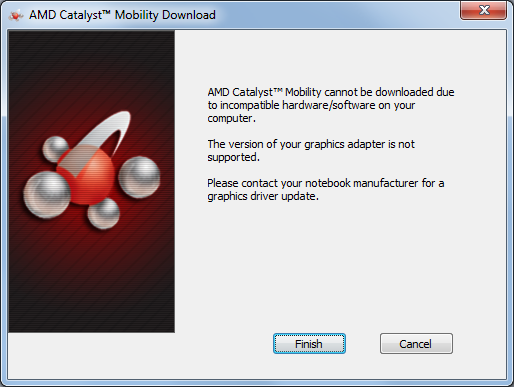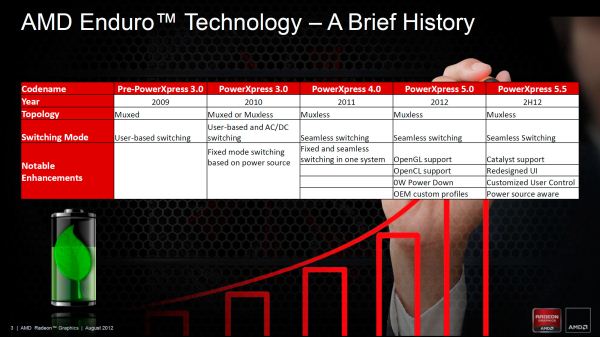AMD’s Enduro Switchable Graphics Levels Up
by Jarred Walton on September 6, 2012 3:00 AM ESTRecap: AMD’s PowerXpress, aka Dynamic Switchable Graphics, aka Enduro
Getting back to the switchable graphics, AMD has gone through a variety of names over the years. Here’s AMD’s summary slide, which I’ll discuss in detail:
Originally introduced as PowerXpress back in 2008, the first AMD switchable graphics solutions were like that found later in the ASUS UL80Vt and similar laptops: you had to flip a switch, and in the first iterations you would then need to reboot the laptop so that the BIOS could disable the discrete GPU and activate the integrated GPU. It was messy and a bit inconvenient, and NVIDIA’s early studies showed that many users ended up not using the feature—they would either run on dGPU all the time or on iGPU all the time. Both AMD and NVIDIA had a second series of switchable graphics designs where the need to reboot was removed; the first Alienware M11x could switch GPUs in about 10-15 seconds, and the same was true of HP’s first ENVY laptops. These were using PowerXpress 2.0 and 3.0, and for most people the switching side was adequate: you’d run on dGPU when plugged in and switch to iGPU when on battery power.
Last year, AMD took a step forward with their switchable graphics by introducing PowerXpress 4.0, which also renamed the technology to Dynamic Switchable Graphics (DSG for short). I got a chance to do a head-to-head of the technology using a Sony VAIO C laptop provided by NVIDIA. You know a company is confident that they’re going to win a technology comparison when they’ll actually give you a competitor’s product. In some cases, DSG was just as good as Optimus: you could launch a supported game and never realize all the extra stuff happening in the background; unfortunately, there were several titles where it wasn’t quite as convenient as we would have liked, and OpenGL support from DSG was completely missing.
Step forward to early 2012 and we got another update to PowerXpress 5.0 (note that PowerXpress is now only used internally by AMD and hasn’t been their marketing name since before PX4.0) along with a rechristening: Dynamic Switchable Graphics was out and Enduro was in. If nothing else, at least it makes my job easier as Enduro is much more concise. There's also the fact that the GPUs are no longer "switching", as the iGPU is always running; now the dGPU is simply supplementing the iGPU when needed. Along with the name change, AMD added OpenGL and OpenCL support to the mix, and with their Zero Core Technology (which is also part of their 7000 series desktop GPUs—a case of mobile design influencing desktops) the need to keep a small portion of the chip alive (aka BACO: Bus Active Chip Off) was removed. OEMs could also ship with custom profiles for applications, so for example Dell might want all of their extra utilities to default to running on the iGPU.

Hopefully this problem goes away next month!
Other than those changes, the UI and driver updates situation on early Enduro solutions remains largely the same as with DSG/PX4.0—and that’s what I initially received with the Clevo P170EM, with drivers from around March 2012. A quick check at AMD’s site also let me know that there weren’t any new drivers available, as the P170EM wasn’t currently supported by the latest Mobility Catalyst drivers.











200 Comments
View All Comments
Seanzky - Friday, September 7, 2012 - link
They really should take this seriously if they want to stop slipping away from that market share they're dearly hanging on to. There are many like me who shop for the best bang for my buck, but won't hesitate to drop close to a grand just in order to avoid "learning another lesson."dczyz - Thursday, September 6, 2012 - link
Until they change their driver practice of only the laptop manufacturer supplying the drivers, I will avoid AMD for any switchable solution.kyuu - Thursday, September 6, 2012 - link
If you read the article, you'd see this is one of the issues that's supposed to be addressed. Anybody with an Enduro laptop should be able to use the generic drivers direct from AMD. This assumes that the OEMs don't make a fuss for whatever stupid reason, but if that happens, that's the OEMs' fault, not AMD's.dczyz - Thursday, September 6, 2012 - link
I understand that argument, but I dont care :)I know that if I go with Nvidia, I can trust them to keep my drivers working and updated. Until AMD makes that commitment, no thanks.
Vozier - Thursday, September 6, 2012 - link
you "trust" Nvidia a bit too much, in the past this hasnt always been the case.Dont kick the man in the ground, let it stand back up and fight fair.
We all know forums are NOT the place to make commitments, it almost always ends up with people yelling back to whatever one says.
For me is much more reassuring to read a "public announcement" of sorts made by AT an Jarred here. Of course we cant reply or ask questions, but thats not really what we want. We want a working driver, and as long as they work on it I will not ask them to loose time asnwering to every question and complaint.
I work in a hosting company and, no matter how much people you have, when there is a problem you want to adress it and not loose time trying to explain hundreds of people something not even you have clear at the time.
The damage is already done, no doubt about that, but lets be patient and hope for the best.
regards
Voz
extide - Thursday, September 6, 2012 - link
Lol, obviously you didn't understand, as your EXACT complaint is being addressed!tspacie - Thursday, September 6, 2012 - link
It's a small thing, but they're not using LDA on the Clevo.GPUs can be linked when they are controlled by the same kernel-mode driver. They could use LDA on computers with an AMD iGPU and dGPU, but not when an Intel driver controls the iGPU.
JarredWalton - Thursday, September 6, 2012 - link
You'll have to take that up with AMD, as they specifically told me they use LDA for Enduro on all systems.tspacie - Thursday, September 6, 2012 - link
Huh. They are either very clever, very strange or very wrong. :)Thanks for the response.
Wolfpup - Thursday, September 6, 2012 - link
I keep being blown away that an enthusiast tech site that strives for accuracy like this-that rejected DonutMark for years because it's a joke, and still goes "eh, here's this dumb thing if you want it" would keep pushing Floptimus and AMD's equivalent.I have NEVER seen a knowledgeable consumer asking for switchable graphics. It STILL causes all sorts of pain...heck, we're STILL at the point that even with Nvidia, even WITHOUT Optimus, not all notebooks are supported by Nvidia's drivers. Throw Optimus in there and problems just shoot up astronomically. There are forums full of people trying to disable Optimus, flash BIOSes to get rid of it, etc. because of all the problems it brings, and AMD has never been able to match Nvidia's drivers even WITHOUT the complexity of switchable graphics.
Why the HECK is AMD constantly supporting this garbage? If power draw is really such a big deal, lets get better power gating and the like.
Heck, Anandtech should be decrying Intel and AMD's integrated graphics solutions entirely. In both cases, they use piles of transistors that could instead be used for extra cores and cache, or even better designs that might be possible with more transistors. OR they could at least cost less and use less power because they're not powering 200 million + transistors of junky video.